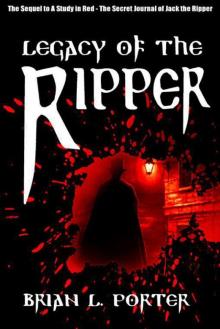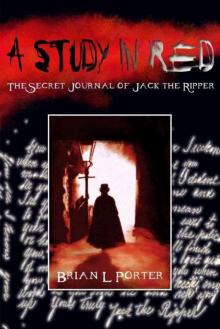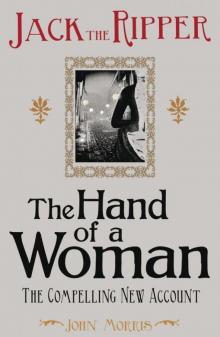Jack the Ripper: The Hand of a Woman Read online
JACK THE RIPPER
THE HAND OF A WOMAN
JOHN MORRIS
‘Heaven has no rage like love to hatred turned,
Nor hell a fury like a woman scorned.’
William Congreve, The Mourning Bride, III, 8
For Dad, a hard act to follow
CONTENTS
Title Page
Epigraph
Dedication
Acknowledgements
Prologue
Chronology of the Murders
Chapter 1
Chapter 2
Chapter 3
Chapter 4
Chapter 5
Chapter 6
Chapter 7
Chapter 8
Chapter 9
Chapter 10
Chapter 11
Chapter 12
Chapter 13
Chapter 14
Chapter 15
Chapter 16
Chapter 17
Chapter 18
Epilogue
Appendix I
Appendix II
Bibliography
Copyright
ACKNOWLEDGEMENTS
One name, more than any other, conjures up images of thick swirling fog, dark Victorian passageways and shadowy gas-lit squares, brutally slaughtered victims, a faceless murderer clutching a blood-stained knife, and a timeless unsolved mystery… Jack the Ripper.
Several years ago, and long before the prospect of writing my own book about this most elusive of all murderers ever occurred to me, I visited a London bookshop. There I skimmed through the pages of another Ripper paperback, the title of which I am now unable to recall. Recently I was reminded of a brief passage from that work. The author mentioned that, during the course of his writing, he felt there were three people living in his home, although the dinner table was only ever laid for two. The third occupant in the household, the uninvited guest, was of course Jack. During the latter period when I was working on Jack the Ripper: The Hand of a Woman, I felt the same way, but it was not the murderer who shared our family home.
After our investigation started, but well before it finished, sadly my father, Byron Morris, died aged ninety-six. An aircraft engineer by profession, many of his earlier years were spent pursuing his hobby of watchmaking, the very same part-time activity enjoyed by Detective Inspector Frederick Abberline, the co-ordinating officer instructed by Scotland Yard to track down the Whitechapel murderer. The last years of my father’s life were devoted to historical research, and in this field he made many unexpected discoveries, of which the true identity of Jack the Ripper and the motive for the terrible crimes are just two.
After his death, I continued with our project alone, but I always felt that he was standing at my shoulder helping and encouraging me. Sometimes when I was uncertain how to proceed, a small voice would make a suggestion that invariably turned out to be the right one; at other times I would ask my father for advice and it was always given; whether this was from my subconscious and the many years of his welcome guidance and influence, or perhaps a voice from beyond the grave, having checked various aspects of the case with the original sources, I do not know. But whichever is correct, I am truly grateful for his encouragement, help and love.
I wish to thank Jonathan Williams, my literary agent, for his dedication, impeccable editorial advice, incisive judgement, so much selfless hard work, and of course, his friendship. Without him, this book, to which he contributed so much, would never have seen the light of day and, I have little doubt, the truth about the murders would never have become known.
I also wish to thank Mick Felton of Seren; not only for publishing my work, which almost goes without saying, but for his true professionalism, commitment and acuity in showing me what more was needed to make the original account so much more compelling, and I hope, more enjoyable too.
My thanks also to the management and staff of Druids Glen Resort for their kindness in allowing me the extensive use of their business facility.
With grateful thanks also to my wonderful family, my fiercest critics who encouraged me from the outset; for their invaluable suggestions, sometimes solutions, and always absolute confidence, my sister for a historical perspective, and particularly my wife Yvonne, for her infinite patience and the inexplicable trust she placed in me. I shake my head as I wonder why.
John Morris
Druid’s Glen, Co. Wicklow, Ireland, July 2011
PROLOGUE
I clearly remember my first eureka moment, that split-second when, in an instant, everything became crystal clear, and the previously obscure was now bindingly obvious.
I was born in the early 1950s and grew up in rural Northamptonshire during an era when young children were expected to listen to what their elders had to say. Usually I found their talk to be dull, but occasionally the conversation would become more interesting. At such times, I would listen eagerly and the hours would fly.
It was on one of these occasions that I heard about a mysterious character called Jack the Ripper. He captured my imagination and has continued to haunt my life ever since. He was said to have murdered his unfortunate victims, all ‘fallen women’, in London’s East End district of Whitechapel during the autumn of 1888. The killings were all brutal, bloody and carried out using a scalpel-sharp knife. One of the reasons for his notoriety was that he was never caught.
There was great conjecture about the murderer’s identity; was he a doctor, a lawyer, or even a member of the Royal Family? Some of those whose enthralling discussions I absorbed so readily had been young themselves in 1888. The impact that the events of that year made on them must have been immense, because more than 70 years afterwards, they were still talking about the murders.
So it has been for me too. From my early introduction to the present day, I have theorised endlessly about the murderer’s identity and possible motives for the terrible crimes. I devoured anything and everything on the subject, from books, newspaper and magazine articles, to cinema, television and radio programmes. Cuttings about the ‘latest discovery’ are crammed inside the covers of more than fifty books about the Ripper on my bookshelves.
Four authors in particular have influenced my views on the Whitechapel murders. Stephen Knight, in his best-selling book Jack the Ripper: The Final Solution (1976), declared that he had solved the mystery once and for all. The Manchester Evening News review of the book asserted that Knight had “tied up so many loose ends”. Prince Albert Victor, Duke of Clarence, a grandson of Queen Victoria, had married a Catholic in a secret ceremony and she had given birth to his child, Knight claimed. When the Establishment found out about the affair, the young woman was abducted and disappeared following a police raid, and her friends, five prostitutes from Whitechapel, then tried to blackmail the Royal Family. Sir William Gull, the Queen’s surgeon, had taken it upon himself to solve the problem. As a high-ranking Freemason, he set about his task in what was alleged to be true Masonic style; tracking down each of the conspirators, then cutting their throats and disembowelling them. The bodies of one of the victims was discovered in Mitre Square, which, Knight maintained, held great symbolic significance for Freemasons, while another had her intestines thrown over her shoulder, as further evidence of Masonic ritual and involvement.
For a while, this hypothesis satisfied me and I convinced myself that the case had been solved at last, but it troubled me at the same time. Though I couldn’t quite put my finger on it, something was wrong, including the question of which shoulder was demanded by Masonic ceremony, and all the loose ends had most definitely not been tied up.
The Whitechapel murders raise many questions, most of which have never been satisfactorily answered or expla
ined. Why was the throat of the first victim, Polly Nichols, cut twice – when she was already dead? She had been suffocated or strangled – as evidenced by the dark blue colour of her tongue according to the medical report of Dr Rees Ralph Llewellyn, the police surgeon who performed the post mortem.
Why, when the second victim, Annie Chapman, was murdered, was the pocket of her apron almost torn off? For what reason were a number of personal items arranged neatly by her feet? Why, and for what reason, was Chapman’s uterus ripped out of her body and taken away by the murderer?
When Elizabeth Stride’s body was discovered, lying inside an open gateway in Berner Street, only her throat had been cut and nothing more. Why just a cut throat when, up to that point, the injuries inflicted on the two previous victims had been getting worse in their severity?
When Catherine Eddowes’s mutilated body was found in a dark corner of Mitre Square, why was the inverted letter ‘V’ carved into each of her cheeks and what did it mean? Why were her nose, ears, lips and eyelids slashed? And why had her uterus and left kidney been cut out of her body and removed from the scene of the crime?
What was the meaning of the cryptic message inscribed on the black brick door surround at the Wentworth model apartments in Goulston Street?
The Juwes are
The men That
Will not
be Blamed
for nothing
Were they written in the murderer’s own hand? And did the murderer deposit a bloodied part of Catherine Eddowes’s apron on the ground in the doorway, to draw attention to the strange message, as has been supposed, or might there be an entirely different explanation for both the writing and the severed part of the soiled apron?
Mary Jane Kelly, a young, pretty Irish girl, was the murderer’s fifth and final victim. Said to have been born in Limerick in Ireland, Mary Kelly moved to Wales with her family when she was very young. While she lived in Wales, the young Mary learned her new tongue and adopted the accent of her childhood friends. She later lived with a cousin in Cardiff before moving to London in 1884 with her young son. She was just twenty-one.
Four years later, Mary Kelly was killed in her tiny rented room during the early hours of a cold November morning on the day of the Lord Mayor’s Show. She was more horrendously disfigured than any of the previous victims, and her death posed the most important question of all.
After that murder, Mrs. Caroline Maxwell, a housewife, gave a written statement to the police, and later also swore on oath at Kelly’s inquest, that she had both seen the victim and carried on a conversation with her at the entrance to Miller’s Court where Mary Kelly had lived. But this had happened, Mrs Maxwell insisted, several hours after it has been conclusively established that Kelly was dead. How was this possible?
A more general question was why the murderer appeared to have no sexual interest in any of the victims? None of them had been raped, or sexually interfered with, or had their undergarments removed – save for the purpose of cutting up their bodies. And all of them, with the exception of Mary Kelly, appeared to have voluntarily lain down, as though they were expected to perform the sexual act.
Was it significant that the first four murders took place within the relatively short time-frame of thirty days, while the fifth and last killing took place more than five weeks after the fourth murder? Was there some reason for this delay, and, if so, what might it have been?
What was the catalyst for the murders? What momentous event or series of events could have turned someone into a brutal, serial killer – carrying out horrific murders, almost beyond comprehension, even by the standards of Ed Gein, on whose character Alfred Hitchcock’s Norman Bates and Tom Harris’s Buffalo Bill were both based? Edward Theodore Gein, born in 1906, a serial killer from Plainfield, Wisconsin, whose gruesome death toll is unknown, adopted the practice of murdering his victims, then fashioning household items from their skin, bones and body parts. Convicted of murder in the first degree, Gein was found legally insane and committed to a mental hospital, where he remained until his death in 1984.
Why did the murders end with the inconceivably savage disfigurement of Mary Kelly? Had the murderer finally achieved his purpose, and if so, what was that purpose?
And finally, the most elusive question of all: why was the murderer never caught?
None of these questions has ever been answered satisfactorily.
Philip Sugden’s The Complete History of Jack the Ripper (2002), a meticulously researched almanac, provides information on almost everything that anyone could wish to know about the Whitechapel murders – except the answers to the questions who and why? But while Sugden did not actually provide the answers I was looking for, at least he succeeded unwittingly in pointing me in the right direction.
I had expected Patricia Cornwell’s book Portrait of a Killer: Jack the Ripper Case Closed (2002) to provide the conclusive evidence for which I was searching. But, regrettably, this book also failed to live up to expectations. Despite the thorough and deep research that Cornwell had undertaken, I was disappointed that her proposed suspect, Walter Richard Sickert (1860-1942), the German-born English impressionist painter, was supported by so little, if any, concrete evidence. Her ‘proof’ seemed to consist of several of Sickert’s drawings, pictures, canvases and a number of anonymous and denigrating letters sent to the police which Sickert may or may not have written. The ‘Dear Boss’ letter, delivered to Scotland Yard almost three weeks after the murder of the second victim, Annie Chapman, which Cornwell claimed Sickert had written, was an important pillar of the writer’s case and it was that letter which gave birth to the infamous sobriquet Jack the Ripper. Sir Robert Anderson, Assistant Commissioner of the Criminal Investigation Department, Scotland Yard, declared in Criminals and Crime (1907) that “the letters were the work of an enterprising journalist”, but was unable to provide the evidence needed to substantiate his claim. It was not until well over one hundred years later that his theory was confirmed, by Dr Andrew Cook, in Jack the Ripper: Case Closed (2009), who established that the letter was indeed written by a journalist. Walter Sickert did not write that letter.
Patricia Cornwell also claimed that Sickert suffered from a misshapen penis and was incapable of consummating the sexual act. This, she suggested, caused in him such a hatred of women that he was compelled to murder them, dissect their bodies, and remove their reproductive organs. But at no stage did she explain why the murders began and, just as importantly, why they ended so abruptly. There is no mention in Cornwell’s book of the extraordinary and compelling evidence given by Mrs Caroline Maxwell – which is central to the Kelly murder.
Disappointingly, none of the answers I hoped to find were provided in Patricia Cornwell’s book and there was little or no other persuasive evidence to suggest that Walter Sickert was anything other than an oddity or a misfit – traits that are not sufficient to merit him being called a serial killer.
In 2004, my father, an active and perceptive amateur historian, then aged ninety-two, began to research his latest subject, Sir John Williams, born in 1840, the third of four brothers on a small farm in Gwynfe, a village near Carmarthen in west Wales. John Williams had struggled to rise above his humble origins, and went on to become a physician to royalty and Professor of Obstetric Medicine at University College Hospital in London. In June 1905, after his early and unexpected retirement two years earlier, the deputation he headed won the sixteen-month fight to establish the National Library of Wales in Aberystwyth.
Sometime after the result of my father’s research into the life of Sir John Williams was published in the South Wales Evening Post, the book Uncle Jack (2005) appeared. Within its pages, the author Tony Williams identified his great-great-uncle, Sir John Williams, as “Britain’s most notorious murderer”.
My father refused to believe that Williams, a gifted, brilliant and philanthropic doctor, could possibly be Jack the Ripper. Reading Uncle Jack did nothing to change that view. If anything, it reinforced my father’
s opinion that, while Williams may have shared the same weaknesses as many of his fellow men as far as women were concerned, this did not make him a murderer. In any event, what motive could he possibly have had? Sadly, like all books written on the subject to date, Uncle Jack was also a huge disappointment to me. The many questions and explanations I was seeking remained unanswered.
As my father and I worked our way through the long list of suspects, we listed the essential attributes the murderer would have to have in order to accomplish, and get away with, the terrible crimes: a knowledge of anatomy, some surgical skill, access to specialist knives, the baffling ability to disappear into thin air, and a motive, at the very least, to commit murder. Then my father’s eyes suddenly lit up and he told me whom he thought the murderer could have been….
That was my first eureka moment.
The realisation had come about as he recalled a short extract, just seven words, from a passage in one of the many scores of books we had read. It supported its author’s contention as to the identity of his suspect perfectly, but it didn’t ring true for us. It was only when we turned the passage about, that its true meaning, and the possible identity of the murderer, became clear, and the motive behind one of the murders, at least, was now patently obvious.

 Legacy of the Ripper
Legacy of the Ripper A Study in Red - The Secret Journal of Jack the Ripper
A Study in Red - The Secret Journal of Jack the Ripper Jack the Ripper: The Hand of a Woman
Jack the Ripper: The Hand of a Woman Requiem for the Ripper
Requiem for the Ripper